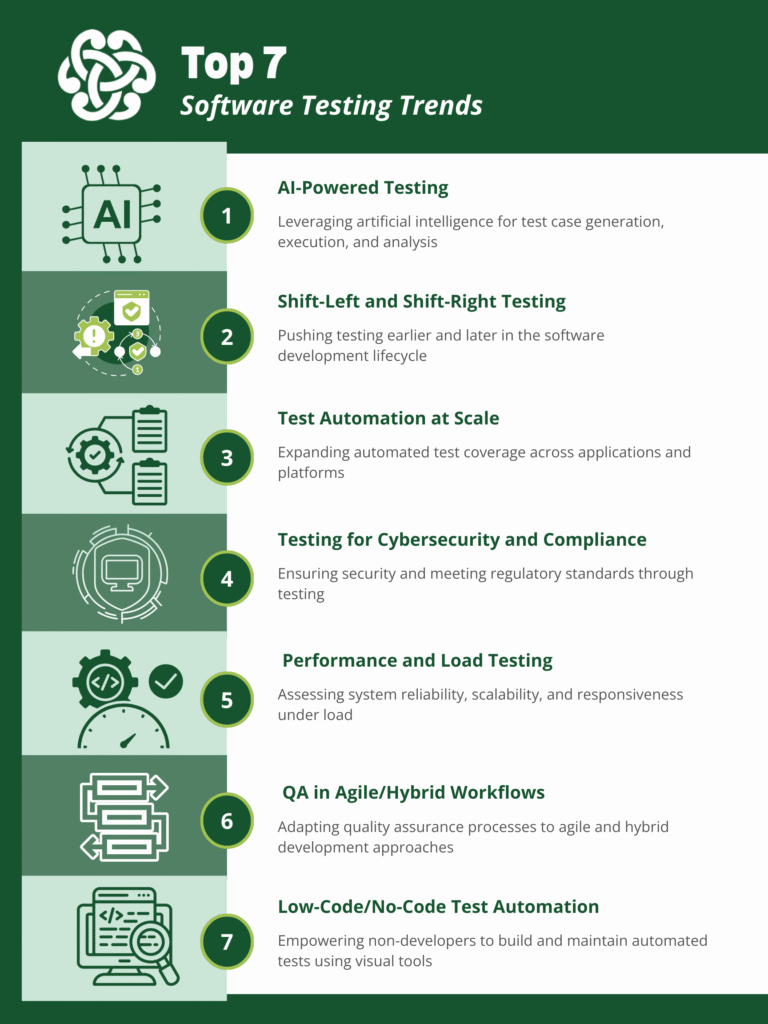The pace of technological change continues to accelerate, and so do user expectations. As companies race to deliver software faster, more securely, and higher quality, CIOs and QA leaders must stay ahead of the curve. Software testing is no longer a back-office function—it’s a critical lever for business success.
In this blog, we’ll explore seven urgent software testing trends reshaping the QA landscape in 2025 and beyond. These trends are essential for anyone responsible for delivering secure, reliable, and high-performing software in today’s fast-moving digital environment.
1. AI-Powered Testing
Artificial Intelligence (AI) and Machine Learning (ML) are transforming software testing by enabling smarter automation, predictive analytics, and intelligent test case generation. AI helps identify high-risk areas, prioritize tests, and even write new test cases based on user behavior data.
Why it matters: Faster feedback loops, reduced manual effort, and improved test accuracy.
Use case: Predictive defect detection in enterprise applications before code hits production.
2. Shift-Left and Shift-Right Testing
To catch bugs earlier and improve post-release resilience, organizations are shifting testing both left (earlier in the SDLC) and right (in production-like environments).
Why it matters: Faster time to market, reduced cost of defects, better coverage.
Use case: Integrating automated tests in CI/CD pipelines while using synthetic monitoring in live environments.
3. Test Automation at Scale
Test automation is no longer optional—it’s foundational. Companies are building scalable, reusable test automation frameworks that support multiple platforms, devices, and release cycles.
Why it matters: Speeds up regression cycles, supports Agile/DevOps, increases test coverage.
Use case: Enterprise-wide automation using tools like Selenium, Cypress, or Playwright, integrated with CI tools like Jenkins or GitHub Actions.
4. Testing for Cybersecurity and Compliance
As threats become more sophisticated, software testing must include robust security validation. Static (SAST), dynamic (DAST), and software composition analysis (SCA) are becoming standard.
Why it matters: Prevents vulnerabilities from reaching production and ensures regulatory compliance (HIPAA, GDPR, etc.).
Use case: Automating security checks in CI/CD to catch issues in open-source components before deployment.
5. Performance and Load Testing
With the widespread adoption of cloud-native architectures, it’s crucial to validate how software performs under real-world conditions.
Why it matters: Ensures scalability, stability, and optimal user experience under high demand.
Use case: Load testing APIs and UIs using tools like JMeter or k6 to simulate thousands of users.
6. QA in Agile and Hybrid Workflows
The role of QA is evolving within Agile and hybrid teams. Testers now collaborate more closely with developers, product owners, and DevOps engineers.
Why it matters: Enhances communication, reduces bottlenecks, and improves overall delivery quality.
Use case: Embedding QA engineers into Scrum teams to conduct exploratory and automated testing throughout each sprint.
7. Low-Code/No-Code Test Automation
Low-code and no-code platforms are enabling non-technical team members to contribute to testing. These tools simplify test creation and maintenance.
Why it matters: Increases testing capacity, reduces time to automate, democratizes QA.
Use case: Business analysts using low-code tools like Testim or Leapwork to create end-to-end test flows.
Final Thoughts
These seven trends are shaping the future of software testing. By understanding and adopting them, CIOs and QA leaders can reduce risk, accelerate release cycles, and improve software quality.
Looking to future-proof your QA strategy? Schedule a call with our testing experts to learn how we can help you implement these trends.


